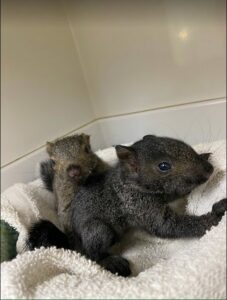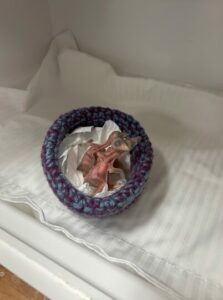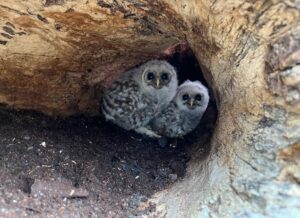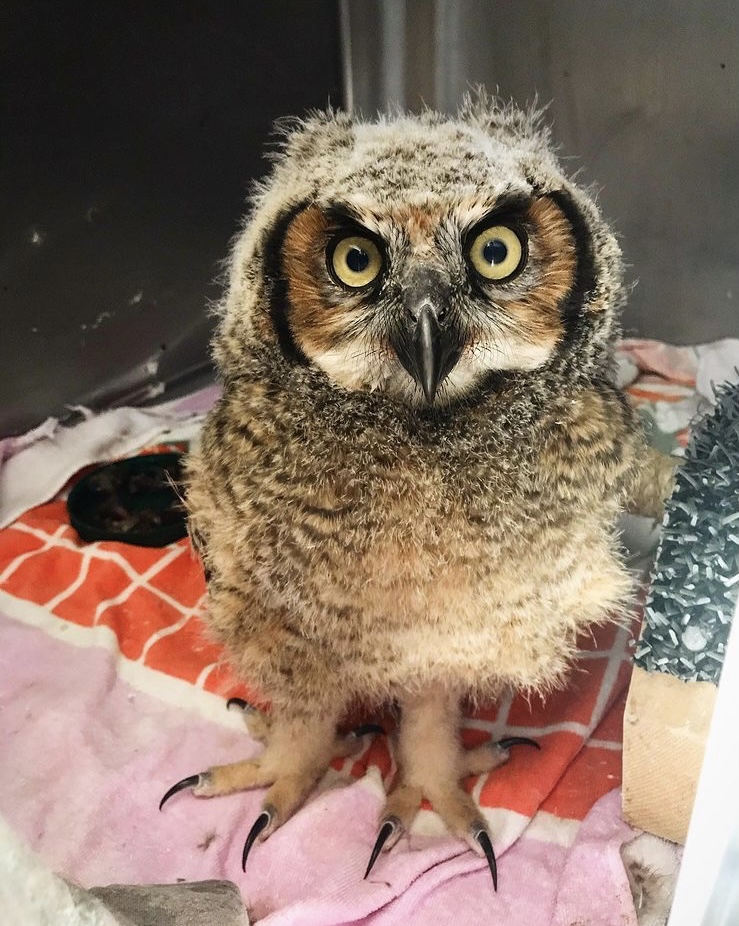It’s that time of year again when we are all itching to go outside and spruce up our yards. One project that usually begins in the spring is cutting down unwanted trees. However, while we are trying to make our yards more aesthetically pleasing, removing trees during the spring and summer months can be detrimental to wildlife. Baby season is well underway during this time, and many of our wildlife friends use trees as their nesting locations. Today, the Northwoods Wildlife Center would like to discuss why you should wait to cut down trees during the spring and summer months and what to look for before cutting down your tree.

Trimming and cutting down trees can, and does, harm and even kill a variety of baby animals during the spring and summer months. In fact, last year, the Northwoods Wildlife Center admitted 147 baby animals; out of those, 40 were admitted to us due to injuries from tree trimming and habitat destruction caused by tree removal. Even the sound of chainsaws can scare parents away from their young, causing crucial feedings to be missed, and in the worst-case scenario, the parents may not return due to the disruption. Many animals that use trees for their nesting sites often have more than one litter or brood a year, resulting in baby season in your backyard lasting throughout the summer. Due to this, wildlife rehabilitators and enthusiasts encourage tree trimming or cutting once the baby season is over.

Besides harming wildlife, trimming trees in the spring is harmful to the trees themselves. During the spring, diseases and harmful insects are no longer dormant, and when you trim your trees in the spring, they can spread to other trees. In addition, trees that are trimmed in the spring may not have enough time to heal, making them more susceptible to unwanted pests and diseases.
Standing dead trees provide nesting sites for bats, woodpeckers, squirrels, and cavity-nesting owls. Being that these trees might not be the ideal look that you are going for in your backyard, if it is safe for you to hold off on cutting down these trees, or any tree for that matter, until late fall or winter, you would be doing wildlife and their young a considerable favor. Of course, if a tree is dangerous due to the chance of it falling, we understand that the only option might be to cut it down as soon as possible.

So, what are some signs that you have an active nest in your tree? For some critters, such as songbirds and non-cavity-dwelling raptors, the easiest thing to do is look up. When leaves haven’t completely flourished in the spring, it is much easier to spot bird nests. Although still possible once leaves are abundant on trees, you will have to thoroughly examine your tree to spot these nests. Eastern grey squirrel and Red squirrel nests are also easy to spot in your tree. Their nests are made of a bundle of leaves known as a drey, usually high in the tree and close to the trunk. Both squirrel species will also use a cavity within the tree, making it a little trickier to determine if someone is home. In this case, the best thing you can do to determine if there are squirrels in your tree is to check for cavities and then monitor the tree for as long as possible before cutting it down. If you see a lot of squirrel activity on and around the tree, there is a good chance that they have made themselves at home. Barred Owls and woodpeckers are also cavity nesters, so just like squirrels, check your tree to see if there are any cavities in it. If you see a cavity, monitor the tree, and if you have noticed adult Barred Owls or woodpeckers flying back and forth to the tree or hanging out near the tree, there is a good chance there is a nest in your tree.
Unfortunately, just because you have identified nesting activity in your unwanted tree doesn’t mean that all you have to do is wait a few weeks. Almost every species that chooses your tree as a nesting site will use the tree through the summer. Although songbird and woodpecker young fledge within three to four weeks, in most cases, the parents will reuse that nest for their next brood. Baby squirrels stay with their mom for four months before venturing out on their own, and baby raptors take up to seven weeks to fledge, depending on their size. Even after fledging, mom and dad teach their young how to hunt, resulting in them staying in the area for several months.
All in all, if you can wait until late fall and into winter to remove nuisance trees, when the baby season is over, and your trees go dormant, the wildlife and the trees in your backyard would greatly benefit. If you need to remove a dangerous tree and find babies afterward, please get in touch with your local wildlife rehabilitator.
Thank you to the following sources for providing information for this post:
https://www.backyardecology.net/if-you-need-to-cut-down-a-tree-do-it-in-the-winter/
https://www.paws.org/resources/safe-pruning/
https://discoverwildcare.org/stop-dont-trim-that-tree/
https://www.reconnectwithnature.org/news-events/the-buzz/check-trees-squirrel-nests-before-tri

